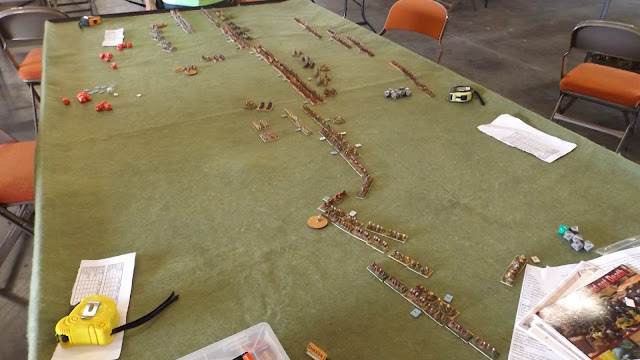Historically after exchanging bow fire for a while the Persians attacked the Arabs on the Byzantine right, drove them off and forced the Byzantines to fall back towards the river where they held out until the Persians withdrew. The game was to follow a different path. The Persians appeared to shift towards their right as they advanced. There was an exchange of missile fire where the Byzantines came off the worse. Though the Byzantines scored as many hits as the Persians, because the Byzantines were in close order and the Persians were in open order, the Persians were able to attempt saving throws and made almost all of them. The front line of Byzantine cavalry had started in open order, but had changed to close order with the second line filling the gaps.
The Byzantine cavalry then charged the Persian cavalry facing them taking some additional losses from missile fire as the Persians evaded. The Byzantine cavalry now ran into the Persian second line. At this time, other than the Bucellarii, the Byzantine cavalry was mostly armed with bows and swords. The second line of Persian cavalry was armed with lances in addition to their bows. As such they were equal to twice as many of the Byzantine horse in combat and were able to hold against the Byzantine onslaught. Meanwhile the Arab allies of both armies had engaged on the other flank.
Fighting was intense. The Arab allies of the Byzantines were doing as well as their opposites, but the Byzantine cavalry was taking more casualties than the Persians. The Persian cavalry which had evaded was rallying and would soon be returning to join the fighting. At this point the Byzantine general commanding the infantry was slain. The Byzantine infantry held and continued fighting. Then the leader of the Persian Arab allies died, causing most of the Arabs to leave. A couple of units of Arabs continued fighting with one of them seeking revenge for the loss of their leader. The next to fall was Azarethes, the Persian commander. At this point the Persians conceded and withdrew.
All of the leader losses had taken place during the same round of combat. For this game I had decided to test an alternative method of checking for leader losses that used a pair of six sided die instead of a single ten sided die. Numerically this would result in their being less of a chance of a leader being killed. However, the die rolls were such that the three leaders were lost. The procedure was to declare whether the losses received during the current turn by the unit the general was attached to were to be added or subtracted to the score of two six sided dice. If the total was 13 or more, or one or less, then the general was lost.
Rules used were Scutarii. Most of the Byzantine and Persian armies were from Heroics and Ros. The Arabs on the Byzantine side were from Irregular and those on the Persian side were from Heroics and Ros and Rapier. The Rapier cavalry mixed well with the Heroics and Ros cavalry. Some of the Persian cavalry and Byzantine infantry were from Baccus. The Persian commanders were Nick Cuaresma and Brent Burdine. The Byzantine commanders were Mike Nankervis and the fellow from the morning game who left before I got his name.
The Byzantine commanders discuss their plans. Mike, as Belisarius in the background.
Persian commanders ready for action. Brent on the left Nick on the right.
The Byzantines respond to the Persian advance.
View from the side of the Euphrates. Byzantine cavalry has chased off the front line of Persian cavalry and is engaging the Persian second line.
The fighting continues. As can be seen the Byzantine infantry has taken more losses than the Persian cavalry facing them.
Back to the other side where the two different tribes of Arabs are fighting each other.
The Persian Arab allies rout following the death of their leader.
Results of the fighting between the Byzantine and Persian cavalry. Several units of Byzantine cavalry have become shaken while Persian morale is still steady despite their losses.
Belisarius and the remaining Persian commander discuss terms following the battle.










1 comment:
Looks like a great day Bill!
Post a Comment